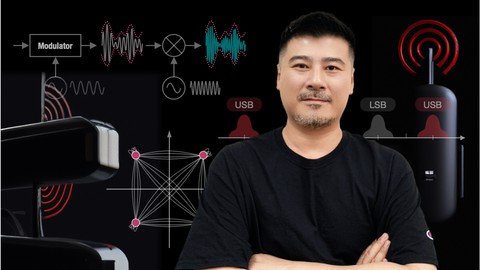The Ultimate Crash Course For Rf Transceiver Fundamentals

Published 5/2023
MP4 | Video: h264, 1280x720 | Audio: AAC, 44.1 KHz
Language: English | Size: 910.48 MB | Duration: 3h 30m
Never again struggle with comprehending the concepts of RF transceiver and digital communications.
Free Download What you'll learn
Modulation and demodulation techniques for wireless communication.
RF transceiver architecture and its principles.
Skills to comprehend RF transceiver system.
Phasing techniques.
Constellation diagrams.
Requirements
Basic understanding of phasors is helpful, but not a neccessity.
Description
Nowadays, having a deep understanding of wireless communications enhances the career prospects of electrical and electronics engineers.Are you fascinated by the world of wireless communications and eager to explore its underlying principles?Are you having difficulty comprehending the complexities of modulation, transceiver architectures, and digital communication techniques?Are you seeking for a comprehensive course that can assist you in mastering the fundamental skills required for wireless communication systems?Look no further than "The Ultimate Crash Course for RF Transceiver Fundamentals" - The final course in The Tao of Phasor Series.The aim of this course is to provide a simplified and easily understandable approach to RF transceiver and digital communications.This course encompasses the fundamental knowledge required to gain entry into the field of RF transceivers and digital communications:With high-quality content and insightful lessons, you'll have a solid foundation in RF transceivers and digital communications.Our focus is not just on the HOW, but also on the WHY and the evolution of analytical methods in this field.We will highlight the crucial factor - the time-varying phasor, in comprehending RF signals and systems.We will present specific examples of modulated signals and their conversions in frequency to provide a clear understanding.Without difficult math! By the end of this course:You'll have a solid foundation in wireless transceiver architecture, modulators, and demodulators. To name a few, linear transmitter, linear receiver, polar transmitter, polar recevier, I/Q modulator and demodulator, DSB/SSB modulator, etc.You'll learn the purposes of VCOs, phase-locked loops, mixers, power amplifiers, and low-noise amplifiers, etc.You'll learn about thec concepts of modulation techniques such as AM, FM, PM, amplitude shift keying (ASK), phase shift keying (PSK), quadrature amplitude modulation (QAM), OQPSK, pi/4-QPSK, MSK, etc.You'll learn the practical application of the Hilbert transform, analytic signals, and phasing techniques.You'll also gain a practical understanding of pulse shaping and optimum receivers.You'll be well on your way to mastering the art of wireless communications.Join us on this journey and discover the fun parts of RF transceivers and digital communications!
Overview
Section 1: Overview
Lecture 1 Welcome
Lecture 2 Overview
Section 2: Development of Radio Transmission
Lecture 3 What is Modulation?
Lecture 4 Spark-Gap Transmitter
Lecture 5 Fessenden
Lecture 6 Continuous Wave
Lecture 7 Vacuum Tube
Lecture 8 Armstrong
Lecture 9 The Key to Radio Downsizing
Lecture 10 Why Modulation?
Section 3: Modulation and Transmitter
Lecture 11 Amplitude Modulation (AM)
Lecture 12 Frequency and Phase Modulation (FM and PM)
Lecture 13 Angle Modulation
Lecture 14 Linear Modulation and Complex Envelope
Lecture 15 Linear Modulator (IQ Modulator)
Lecture 16 Linear Transmitter
Lecture 17 Polar Transmitter
Section 4: Demodulation and Receiver
Lecture 18 Linear Demodulation
Lecture 19 Linear Receiver
Lecture 20 Polar Receiver
Section 5: Modulated Spectrum
Lecture 21 Double-sided and Single-sided Spectrum
Lecture 22 Double sidebands (DSB) Spectrum of AM Signals
Lecture 23 DSB and SSB Spectrum of Upconverted Signals
Lecture 24 Spectrum of PM & IQ-modulated Signals
Section 6: Complex Envelope
Lecture 25 Complex Envelope
Lecture 26 Envelope Simulation
Section 7: Phasing Techniques
Lecture 27 Definition of Hilbert Transform
Lecture 28 Transformation of a Cosine Wave
Lecture 29 Spectrum Efficiency
Lecture 30 A Simple Analytical Signal
Lecture 31 Analytical Signal of a Modulated Signal
Lecture 32 Phasing Techniques
Section 8: Digital Communications
Lecture 33 Can Digital Signals Be Transmitted?
Lecture 34 QPSK
Lecture 35 Simple Constellation Diagram
Lecture 36 Constellation Diagram (I)
Lecture 37 Constellation Diagram (II)
Lecture 38 BPSK and 8PSK
Lecture 39 QAM
Lecture 40 Pulse Shaping
Lecture 41 Inter-symbol Interference (ISI)
Lecture 42 OQPSK and pi/4-QPSK
Lecture 43 Optimum Receiver
Lecture 44 Digital Signals in Transceivers
Section 9: Summary
Lecture 45 Conclusion
Lecture 46 Bonus
Students studying E.E. who want to dive deeper into RF transceivers and gain a strong understanding of its fundamentals. This is for you!,Engineers who want to expand their knowledge of RF transceivers and improve their skills. This is for you!,RF design engineers who want to deepen their understanding of the underlying principles of RF transceivers and improve their design capabilities. This is for you!,Educators who are teaching courses in RF transceivers and want to supplement their curriculum with high-quality content. This course is for you!,Examination candidates seeking a way to gain the knowledge necessary to succeed. This is for you!
Homepage
https://www.udemy.com/course/the-tao-of-phasor-crash-course-for-rf-transceiver-fundamentals/Rapidgator
vmhnx.T.U.C.C.F.R.T.F.rar.html
Uploadgig
vmhnx.T.U.C.C.F.R.T.F.rar
NitroFlare
vmhnx.T.U.C.C.F.R.T.F.rar
Links are Interchangeable - Single Extraction
